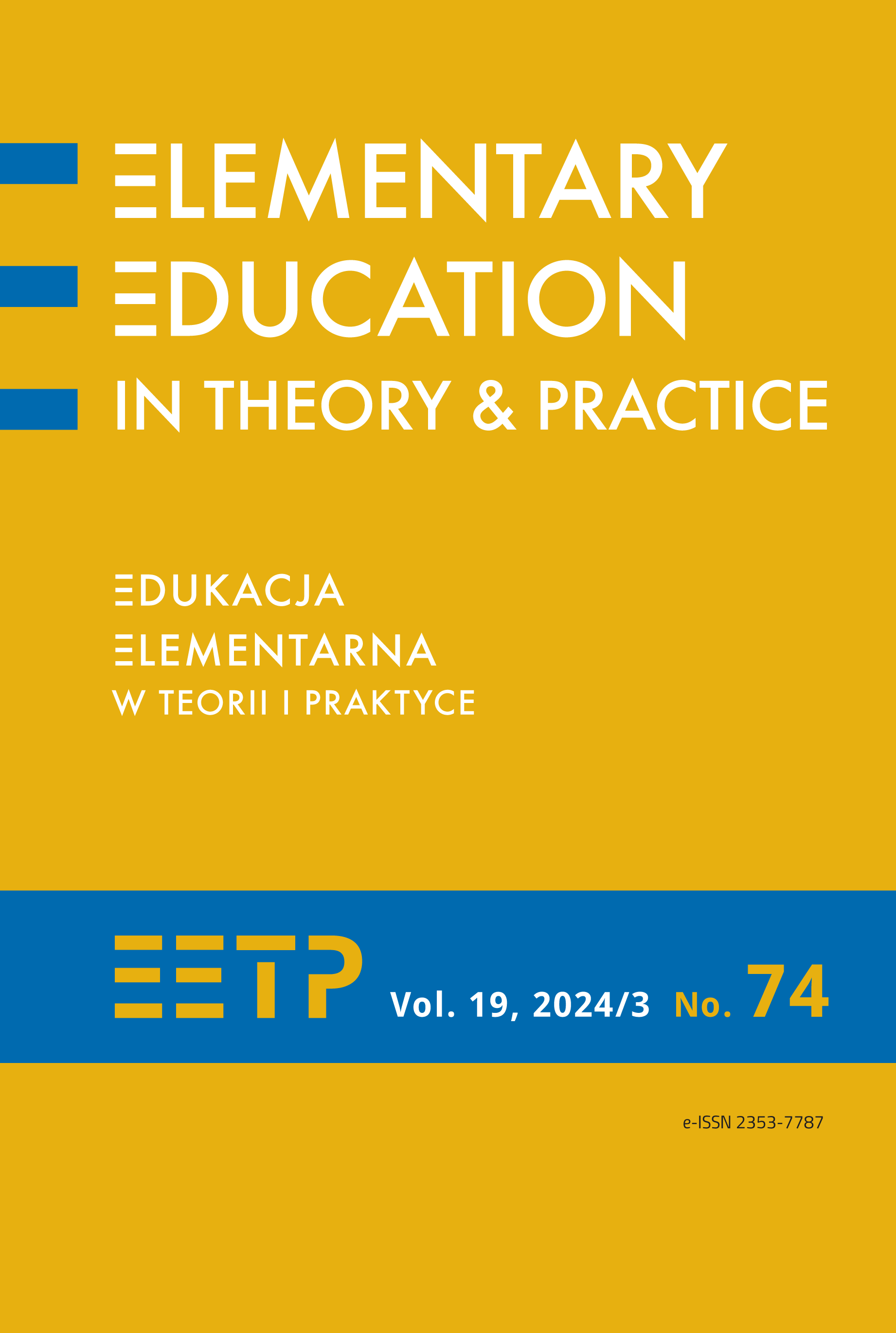Stimulation of Auditory Perception in Children Using Maria Montessori’s Developmental Materials
Abstract
Auditory perception is an important area of a child’s cognitive development because it determines the development of speech and influences writing and reading skills. Irena Polewczyk defines it as “active reception of auditory stimuli scattered around a person, based on the ability to differentiate speech sounds and their analysis, synthesis and interpretation in accordance with the knowledge, memory and experience that a person has” (Polewczyk, 2017, p. 149). The human body is adapted to receive impressions from the outside world; it segregates, processes and interprets them in the mind. In this way, a person acquires experiences that determine the development of subsequent, more and more precise skills. In the process of developing auditory perception, an important role is played by the child’s immediate environment, which, through appropriate interactions, influences the process of shaping auditory functions. The aim of this article is to present theoretical assumptions regarding the development of auditory perception and the possibilities of stimulating auditory development through the use of Maria Montessori’s teaching aids. The first part of the article describes the development of auditory perception in children. Then, theoretical assumptions regarding Montessori development aids and the possibility of using them in developing auditory skills are presented.
References
Erbeli, F., Rice, M., & Pracchini, S. (2022). Insight into dyslexia genetics research from the last two decades. Brain Science, 12(1), 1–14. https://doi.org/10.3390/brainsci12010027
Gordon, R. L., Shivers, C. M., Wieland, E. A., Kotz, S. A., Yoder, P. J., & McAuley, J. D. (2015). Musical rhythm discrimination explains individual differences in grammar skills in children. Developmental Science, 18, 635–644. https://doi.org/10.1111/desc.12230
Grabias, S. (2012). Teoria zaburzeń mowy. Perspektywa badań, typologie zaburzeń, procedury postępowania logopedycznego. In S. Grabias & M. Kurkowski (Eds.), Logopedia. Teoria zaburzeń mowy (pp. 15–72). Wydawnictwo UMCS.
Gruba, J. (2012). Ocena słuchu fonemowego u dzieci w wieku przedszkolnym. Wydawnictwo Uniwersytetu Śląskiego.
Guz, S. (2006). Metoda Montessori w przedszkolu i szkole. Kształcenie i osiągnięcia dzieci. Wydawnictwo Uniwersytetu Marii Curie-Skłodowskiej.
Kruczyńska, A., & Kurkowski, Z. M. (2015). Diagnoza i usprawnianie słuchu fonematycznego i fonetycznego, Nowa Audiologia, 4, 58–66. https://doi.org/10.17431/895774
Kurkowski, Z. M. (1998). Słuch a mowa w aspekcie rozwojowym w normie i patologii. Kosmos, 47(3), 289–296.
Lipowska, M. (2001). Profil rozwoju kompetencji fonologicznej dzieci w wieku przedszkolnym. Oficyna Wydawnicza “Impuls”.
Matczak, A. (2003). Zarys psychologii rozwoju. Wydawnictwo Akademickie Żak.
Maurer, A. (Ed.). (2003). Dźwięki mowy. Program kształtowania świadomości fonologicznej dla dzieci przedszkolnych i szkolnych. Oficyna Wydawnicza “Impuls”.
Michalik, M. (2016). Kompetencja kulturowa jako przedmiot zainteresowania współczesnej logopedii – na przykładzie teorii logopedycznego wiersza pajdialnego. Logopedia, 45, 19–32.
Montessori, M. (2014). Odkrycie dziecka (A. Pluta, Trans.). Wydawnictwo Palatum.
Montessori, M. (2019). Wykłady londyńskie 1946 (O. Siara, Trans.). Wydawnictwo Naukowe PWN.
Polewczyk, I. (2017). Diagnoza percepcji słuchowej. In J. Skibska (Ed.), Diagnoza interdyscyplinarna. Wybrane problemy (pp. 75–96). Oficyna Wydawnicza “Impuls”.
Rocławski, B. (1991). Słuch fonemowy i fonetyczny. Glottispol.
Snowling, J. M., Hulme, Ch., & Nation, K. (2020). Defining and understanding dyslexia: past, present and future. Oxford Review of Education, 46(4), 501–513. https://doi.org/10.1080/03054985.2020.1765756
Styczek, I. (1982). Badanie i kształtowanie słuchu fonematycznego. Wydawnictwa Szkolne i Pedagogiczne.
Tijms, J. (2004). Verbal memory and phonological proccesing in dyslexia. Journal of Research and Reading, 27, 300–310. https://doi.org/10.1111/j.1467-9817.2004.00233.x
Wysocka, M. (2014/2015). Czynniki wspomagające rozwój prozodyczny dziecka. Logopedia 43/44, 121–133.
Wysocka, M., & Kwaterewicz, M. (2018). Program terapeutyczny usprawniający prozodię mowy. Logopedia, 47, 329–348. https://doi.org/10.24335/2y4q-hg06
Zimbardo, Ph. G. (1999). Psychologia i życie (E. Czerniawska et al., Trans.). Wydawnictwo Naukowe PWN.
Copyright (c) 2024 Elementary Education in Theory and Practice

This work is licensed under a Creative Commons Attribution-NoDerivatives 4.0 International License.
- When submitting a text, the author declares that he/she is the Author of the article (hereinafter referred to as the “Work”) and:
- he/she owns the exclusive and unlimited copyright to the Work,
- is entitled to dispose of the copyright to the Work.
Declares that it does not infringe any third party copyrights or legal rights.
Declares that there is no conflict of interest.
2. At the same time, the Author grants the Ignatianum University in Cracowa royalty-free, non-exclusive and territorially unlimited licence to use the Work in the following fields of exploitation:
- recording the Work in a hard copy, as well as on a digital or magnetic medium;
- reproduction of the Work using any technique, without limitation of the number of editions or copies;
- distribution of the Work and its copies on any medium, including marketing, sale, lending, and rental;
- introduction of the Work into a computer memory;
- disseminating the Work in information networks, including in the Internet;
- public performance, exhibition, display, reproduction, broadcasting and re-broadcasting, as well as making the Work available to the public in such a way that everyone can have access to it at a time and place of their own choosing;
- within the scope of dependent rights to the Work, including in particular the right to make necessary changes to the Work resulting from editorial and methodical development, as well as to translate the Work into foreign languages;
The licence is granted from the moment of the transfer of the Work to the Ignatianum University in Cracow. The Ignatianum University in Cracow is entitled to grant further sub-licences to the Work within the scope of the right granted. The licence is time-limited and it is granted for a period of 15 years, starting from the date of its granting.
Authors are permitted and encouraged to publish their text online (e.g. in their institution’s repository or on the institution’s website) before or during the submission process as this may lead to beneficial exchanges, as well as earlier and greater citation of the published text (See The Effect of Open Access). We recommend using any of the following portals of research associations:
- ResearchGate
- SSRN
- Academia.edu
- Selected Works
- Academic Search




